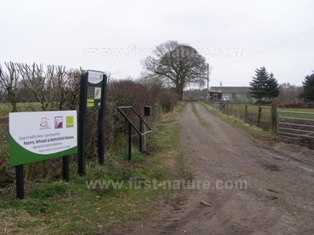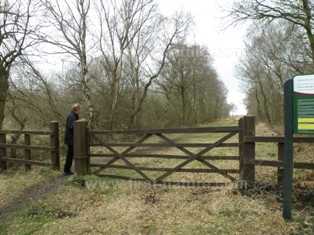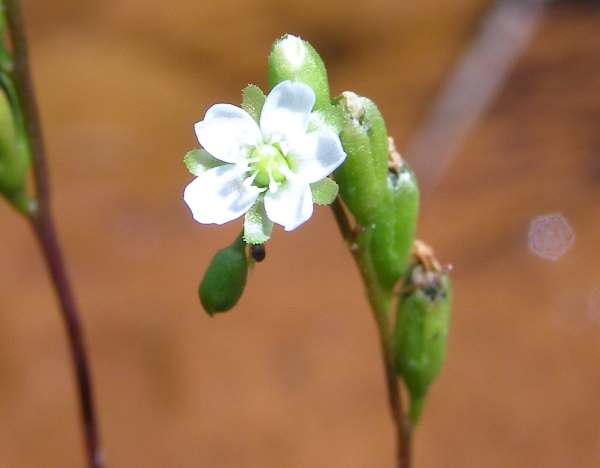Fenn’s, Whixall and Bettisfield Mosses National Nature Reserve
Designations: SSSI
This nature reserve is part of Fenn’s, Whixall, Bettisfield, Wem and Cadney Mosses, which together form Britain’s third largest lowland raised bog SSSI. The reserve is managed jointly by Natural England and Natural Resources Wales (NRW).
Directions
Grid Ref: SJ488370
There are several entrances and points at which the reserve trails can accessed – Manor House Nature Reserve Base, and the Morris’s Bridge entrance have car parks. The easiest point of access is to Manor House (see below) and large vehicles and buses should not attempt access at Morris’s Bridge because there is a narrow hump-backed bridge on the approach.
To reach the Manor House proceed as follows. From the main A525 Wrexham to Whitchurch road, turn right on to the A495 at Redbrook Hunting Lodge towards the village of Ellesmere. Take the first left turn signed with a brown NNR road sign - Fenn’s Bank and Whixall - and proceed about 3km down to the ‘Whixhall’ road sign. Turn right after 100 metres on a sharp left-hand bend and follow a ‘no-through road’ with a pillar box on the corner, and then follow the NNR Base sign. The Nature Reserve Base is housed in portakabin offices about 100 metres further down.
Below: Manor House Nature Reserve Base

Access
The paths through the nature reserve are level and easy to follow, but in places they can become muddy in wet weather, particularly during the winter months.
It is strongly recommended that you keep to the paths, because Fenn’s & Whixhall Mosses are riddled with drains many of which contain deep water that is sometimes covered with floating vegetation. There are three interconnecting ‘Mosses Trails’ that allow you to explore the Mosses and the adjoining Llangollen Canal.
On your first visit the easiest of the trails to find is the one from the Manor House NNR Base, where you can pick up lots of additional information about the wildlife of the reserve.
Description of Site
Below: An entrance to one of the easy-going footpaths

This wonderful nature reserve is worth visiting in any season, although the vast open, brown expanse with which you are confronted during the winter and very early spring is daunting until you realise that, at any time of the year, this site is a haven for a vast and ever-changing pageant of wildlife.
During our most recent winter visit we were urged by one of the wardens to ‘get out there with some binoculars’ as both Little Owls and Curlews were present on the site at the time.
In order to appreciate what Fenn’s, Whixhall and Bettisfield Mosses, and its neighbouring sites managed by Shropshire Wildlife Trust, have to offer it helps to understand the scarcity of the lowland raised bog habitat in Britain and also how nearly this ‘jewel’ was lost to us.
An annual rainfall of between 700 to 1200 millimetres is required to foster the growth of domes of peat, which can tower up to 8 metres above the plain or valley in which they occur. Lower rainfall (although it may feel like more than enough for us!) produces fens, valley mires and other kinds of wetlands habitats that are quite different from that of Fenn’s & Whixhall. Good examples of these other types of wetlands and their habitats can be found on Anglesey at Cors Erddreiniog, Cors Goch and Cors Bodeilio NNRs and also on the Llyn Peninsula at Cors Geirch.
Before human intervention, the raised bog at Fenn’s & Whixhall covered an area nearly 2.5km (1.6 miles) wide and 7.5km (5 miles) in length. The earliest records of peat cutting are from the 1570s, but it was not until 1851 that a succession of commercial peat companies cut Fenn’s Moss, and this exploitation continued until the site was rescued for conservation in 1990. A worse fate than peat cutting could have happened, however, and it is the conversion of sseveral other raised bogs to agricultural land that sealed their fate, rendering them beyond recovery.
Below: Sundew, a carnivorous plant

Many of the plants and creatures that inhabit raised bogs are rare because their habitat is rare: of Britain's total of 1.4 million hectares only 5% consists of raised bog, and less than 6% of this raised bog supports good mire vegetation. Raised bog plants and animals can grow (and new peat form) only when acidic, nutrient-poor stagnant water lies at the peat surface for most of the year. Peat cutting drains this vital rain-water away so that competing plants requiring less water start to grow and thrive at the expense of the raised bog species.
Since 1991 the Countryside Council for Wales and Natural England have worked to restore the reserve to actively-growing raised bog by slowing the rate of water run-off and removing trees and scrub that had smothered the raised bog wildlife. The recolonisation by true peat-forming plants is wonderful to behold, and in spring the birds register their approval with the bubbling call of the curlew (Numenius arquata) and other birdsong echoing around the reserve.
In high summer it is the turn of insects to celebrate the restoration work, and the place hums with the beating wings of clouds of dragonflies and numerous smaller insects which, in turn, provide food for insect-feeding swifts and other birds, and the carnivorous bladderwort and sundew plants.
Butterflies are plentiful, too. Dingy Skipper (Erynnis tages), Brimstone (Gonepteryx rhamni) and Large Heath (Coenonympha tullia) can all be found at Fenn’s, Whixhall and Bettisfield Mosses.
Whether you are a keen bird-watcher, you love plants, are intrigued by insects or just have a general interest in nature, Fenn’s & Whixhall has so much to offer. At least forty-two bird species have been recorded at the reserve including Hen Harrier (Circus cyeius), Nightjar (Caprimulgus europaeus), Long-eared Owl (Asio otus), Golden Plover (Pluvialis apricaria), Peregrine (Falco peregrinus), Merlin (Falco columbarius), Ruff (Philomachus pugnax), Lapwing (Vanellus vanellus) and Yellowhammer (Emberiza citrinella).
Plants include Cotton Sedge, White-beaked Sedge and Yellow Water-lily (Nuphar lutea). Three types of Sundew – Round-leaved Sundew (Drosera rotundifolia), Oblong-leaved Sundew (Drosera intermedia) and Great Sundew (Drosera anglica) - are also present, as are three of the true peat-forming bog mosses – Papillose, Magellanic and Red Bogmoss. In autumn, Cloudberry (Rubus chamaemorus) and Cranberry (Vaccinium oxycoccos) colour the ground with gold and red.
Mammals that make their homes in the reserve include Watervoles, bats, Hares, Polecats and Badgers. Other animals to look out for are frogs, toads, newts and slow-worms (Anguis fragilis); and if you move stealthily you might also see adders (Vipera berus) and grass snakes (Natrix natrix) moving quietly through the undergrowth.
Activities at Fenn’s, Whixhall and Bettisfield Mosses
Every year, from April to July, the wardens at the reserve organise a programme of events that highlight different aspects of the reserve and its wildlife. For more information and to book places contact Caroline Dahn on 0300 060 0583 or by email at: caroline.dahn@naturalengland.org.uk
There is also a Fenn’s Volunteer Group which meets on the second Sunday and the fourth Thursday of each month. To get involved telephone Pete Bowyer on 0300 060 0269 or email at: peter.bowyer@naturalengland.org.uk